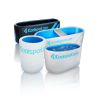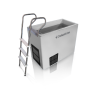Cold Shock Proteins Explained

It’s impossible to explore an interest in health, fitness, or cooking without coming across the term ‘protein’. While dietary protein is vital when it comes to building muscle, there are thousands of equally-important proteins you should be aware of – like ‘cold shock’ proteins.
Here’s what you need to know about these powerful molecules, the benefits they impart, and how you can trigger them safely from your own home.
What are Cold Shock Proteins?
Cold shock proteins are amino acid chains produced by the body when it’s exposed to frosty temperatures. How frosty these need to be is the subject of much speculation. Online, it’s easy to find sources claiming that core body temperatures of 25°C–33°C are needed to upregulate the expression of cold shock proteins, but achieving this level of non-medical hypothermia would mean death in humans.
A more realistic trigger for the production of cold shock proteins is an environmental temperature in the range of 10 – 15 degrees celsius. This is readily found in colder climates, and can easily be replicated through the use of at-home tools such as ice baths.
What Do Cold Shock Proteins Do?
Though research into the topic is still very much in its infancy, cold shock proteins have already been shown to produce a range of physiological effects.
One of the most significant is an apparent ability to stem neurodegenerative diseases. In 2020, scientists at Cambridge University detected markedly elevated levels of neuroprotective protein RBM3 in swimmers who braved Hampstead Heath’s pool during winter. Members of a Tai Chi club who practised beside the pool, but never actually went in, showed no such increase. It’s a promising discovery, particularly given that RBM3 has been linked to prevention of Alzheimer’s and prion diseases in animal models.
Another cold-induced protein, CIRP, has demonstrated similar neuroprotective properties, particularly on those with acute brian injury. It also plays a critical role in skin wound healing, and may help regulate the circadian rhythm – a natural cycle that governs our sleep. This is likely a contributing factor to the enhanced sleep reported by those who undertake cold water immersion.
Though further studies are needed to fully understand its mechanisms, cold shock domain-containing protein E1 (CSDE1) appears to help manage the most common cause of death in Australia and The United States – atherosclerotic heart disease. It does so by regulating the low-density lipoprotein receptor, which controls cellular delivery of cholesterol and clears LDL (bad cholesterol) from the bloodstream. One 2022 study even found it to be as effective as statins in certain circumstances.
How Do You Stimulate Beneficial Cold Shock Proteins?
The cold shock proteins listed above represent just a fraction of those you can take advantage of through regular cold exposure. If you’re interested in harnessing their unique benefits, iCoolsport makes regular cold immersion easy and accessible for everyone.
With features found nowhere else on the market, our revolutionary ice baths are simple to set up, control, and use. The class-leading chillers included in our MiPods units do away with the hassle of buying ice, allowing you to accurately adjust the temperature of your plunge with just a touch. Their energy efficient design can chill water to as low as 2 degrees celsius, so you can easily stimulate cold shock proteins at your own pace.
For sporting organisations and clubs, we also carry pools of up to 12 person capacity. They’re a must for giving your team the competitive edge, or ‘wowing’ guests of your gym or health spa.
For more information about the many mental and physical benefits of cold immersion, be sure to peruse our blog and explore our range online.















